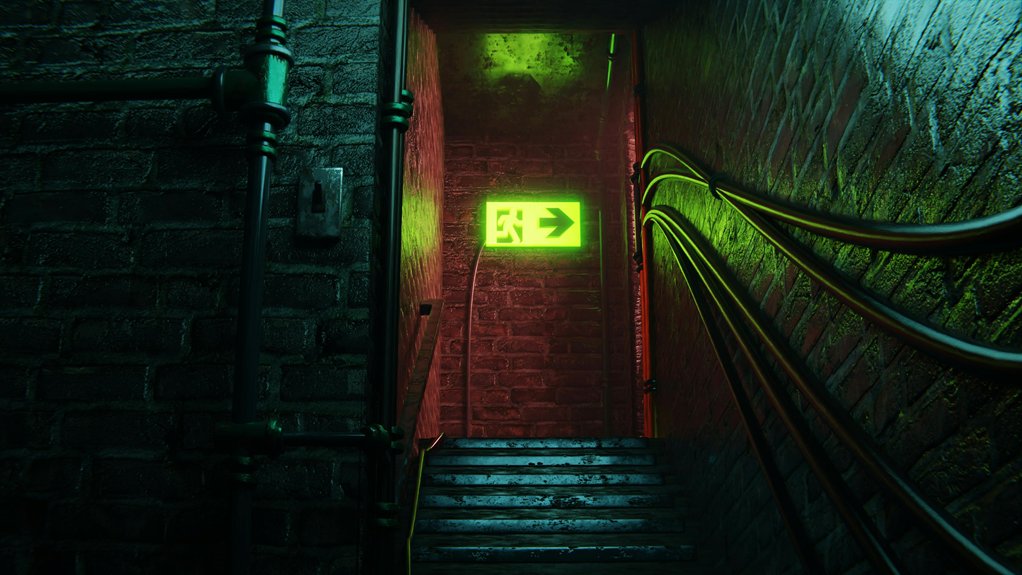If you’ve noticed visible water stains on your walls or floors, it might be time to contemplate basement waterproofing. Musty odors and mold growth can also signal underlying moisture issues. Cracks in your foundation or standing water could threaten your home’s structure and value. These signs not only indicate potential damage but also compromise your living environment. Understanding these indicators can help you make an informed decision about waterproofing your basement. What’s the next step?
Key Takeaways
- Visible water stains on basement walls indicate moisture intrusion, signaling the need for waterproofing to prevent further damage.
- Musty odors in the basement often suggest high humidity and moisture issues, making waterproofing essential for improved air quality.
- Mold and mildew growth can pose health risks and indicates persistent moisture problems, warranting waterproofing solutions to eliminate the source.
- Puddles or standing water in the basement highlight drainage issues, reinforcing the necessity for waterproofing to protect the foundation.
- Cracks in walls and the foundation may compromise structural integrity, making early waterproofing crucial to prevent costly repairs.
Visible Water Stains on Walls and Floors
When you notice visible water stains on your basement walls and floors, it’s a clear sign that moisture is seeping into your home.
Common water stain causes include poor drainage, leaky pipes, or cracks in the foundation. Identifying the source is essential before considering repair options.
You might seal the cracks with epoxy or install a sump pump to manage excess water. Additionally, improving your home’s exterior drainage can prevent future issues.
Don’t ignore these stains, as they can lead to more significant damage if left unaddressed. Taking action now can save you time and money in the long run.
Musty Odors in the Basement
Visible water stains on your basement walls and floors often indicate underlying moisture issues, which can also lead to musty odors lingering in the air. Identifying musty odor sources is vital for maintaining a healthy space. High humidity levels often contribute to these unpleasant smells, so proper humidity control is essential. Consider using a dehumidifier to keep moisture at bay.
| Musty Odor Sources | Solutions | Maintenance Tips |
|---|---|---|
| Water leaks | Repair leaks | Regular inspections |
| Poor drainage | Improve drainage | Clean gutters |
| High humidity | Use dehumidifiers | Monitor humidity levels |
Mold and Mildew Growth
Mold and mildew growth can quickly become a serious problem in your basement, especially if moisture issues persist.
You need to address these threats not just for comfort but for health.
Here are some effective mold prevention and mildew treatment strategies:
- Maintain proper ventilation to reduce humidity.
- Regularly inspect for leaks and seal any gaps.
- Use dehumidifiers to control moisture levels.
- Clean surfaces with mold-resistant products.
- Act quickly on any signs of growth to prevent spread.
Increased Humidity Levels
Persistent moisture issues not only encourage the growth of mold and mildew but also lead to increased humidity levels in your basement.
High humidity can create an uncomfortable environment, damaging belongings and compromising air quality. Effective humidity control is essential for maintaining a healthy space.
Consider investing in a dehumidifier for immediate relief, but don’t overlook moisture management through proper waterproofing. Sealing leaks and applying waterproof coatings can greatly reduce moisture intrusion.
By addressing humidity levels, you’ll not only protect your basement but also enhance your home’s overall comfort and value.
Prioritize these solutions for a safer, drier environment.
Cracks in Walls and Foundation
When you notice cracks in your walls or foundation, it’s crucial to understand what they mean for your home’s structural integrity.
Different types of cracks can indicate varying levels of concern, from minor settling to serious moisture penetration risks.
Addressing these issues early can save you from costly repairs down the line.
Types of Wall Cracks
Understanding the different types of wall cracks is essential for identifying potential issues in your home’s foundation. Cracks can indicate varying levels of severity, so knowing what to look for helps you decide when to take action.
- Horizontal cracks: Often signify pressure from soil or water.
- Vertical cracks: Typically arise from settling or shrinkage.
- Diagonal cracks: May indicate uneven settling.
- Hairline cracks: Usually cosmetic but can be a sign of deeper issues.
- Step cracks: Often seen in brick walls, indicating foundation movement.
Recognizing these types can help you determine if basement waterproofing is necessary.
Foundation Structural Integrity
Cracks in your walls and foundation can be a telltale sign of structural integrity issues that demand your attention.
These cracks often indicate a loss of foundation stability, which can worsen over time. Ignoring them could lead to more significant damage and costly repairs.
If you notice vertical, horizontal, or stair-step cracks, consider seeking professional advice.
Structural reinforcement methods, such as piering or wall anchors, can help restore your foundation’s strength.
Addressing these issues early not only prevents further deterioration but also guarantees your home remains safe and secure for years to come.
Don’t wait until it’s too late.
Moisture Penetration Risks
Ignoring structural issues like cracks can lead to more than just compromised stability; they can also create pathways for moisture to infiltrate your home.
If you notice cracks in your walls or foundation, it’s essential to act. Moisture sources can vary, but you can take effective prevention measures:
- Seal visible cracks with appropriate materials
- Install a sump pump to manage water accumulation
- Guarantee proper drainage around your foundation
- Use vapor barriers in your basement
- Regularly inspect for new cracks and address them promptly
Puddles or Standing Water
If you notice puddles or standing water in your basement, it’s essential to understand the underlying water accumulation patterns.
Analyzing how water collects can reveal issues with your drainage system and soil moisture levels surrounding your home. Addressing these factors promptly can prevent more severe problems down the line.
Water Accumulation Patterns
Water accumulation patterns, such as puddles or standing water, can be warning signs of underlying issues in your basement. You should pay attention to where water collects, as this can reveal problems with water flow or drainage patterns.
Here are key indicators to look for:
- Consistent puddles in the same spots
- Water pooling after heavy rain
- Dampness in corners or along walls
- Mold or mildew growth near standing water
- Changes in water level in nearby drains
Identifying these patterns early can help you take action, preventing more extensive damage and ensuring a dry basement environment.
Drainage System Functionality
Recognizing water accumulation patterns is the first step in addressing potential basement issues, but the functionality of your drainage system plays a significant role in preventing these problems from worsening.
If you notice puddles or standing water, it’s important to evaluate your drainage system types, such as French drains or sump pumps.
Regular drainage system maintenance is fundamental to guarantee proper operation; clogged pipes or damaged components can lead to disastrous results.
Inspect your system frequently and clear debris to keep it functioning effectively.
Soil Moisture Levels
Dealing with soil moisture levels is essential when managing your basement’s health. Puddles or standing water can indicate high soil saturation, which can overwhelm your drainage capacity.
Here are some signs to watch for:
- Excessive puddles forming around your foundation
- Persistent dampness or musty odors in your basement
- Cracks in walls or floors due to soil pressure
- Water pooling in yard areas after heavy rain
- Visible erosion or displacement of soil near the foundation
Addressing these issues promptly can help prevent costly damage and guarantee your basement remains dry and safe.
Consider waterproofing solutions to enhance your drainage.
Efflorescence on Surfaces
While you may not notice it at first, efflorescence can be a significant indicator of moisture issues in your basement. This white, powdery substance forms when water-soluble salts in your walls or floor rise to the surface as moisture evaporates.
Understanding efflorescence causes, like high humidity or inadequate drainage, is vital for effective efflorescence prevention. To tackle this problem, guarantee proper ventilation, fix leaks, and consider applying waterproof coatings.
Water-Related Damage to Belongings
Moisture problems in your basement can lead to more than just unsightly efflorescence; they can cause severe water-related damage to your belongings.
Preserving your possessions is essential, and addressing water damage early can save you money and heartache.
Consider the following items at risk:
- Furniture, which can warp or develop mold
- Electronics, susceptible to corrosion and short-circuiting
- Important documents, likely to become unreadable
- Clothing and textiles, which can develop mildew
- Seasonal decorations, often ruined by dampness
Taking steps to waterproof your basement guarantees the preservation of your belongings and protects your investment.
Conclusion
If you notice any signs like water stains, musty odors, or mold in your basement, it’s time to reflect on waterproofing. Ignoring these issues can lead to more serious problems, including structural damage and costly repairs. By addressing moisture issues promptly, you not only protect your home’s value but also create a healthier living environment. Investing in basement waterproofing now can save you headaches and expenses down the road, ensuring peace of mind for you and your family.

